Vol. 41, #4, Winter 2023
My Summer Vacation in Bogota, Take a YouTube trip to the Colombian mines, Gemstone News, Madagascar Color Change Garnet
- Home
- Newsletter
- Vol. 41, #4, Winter 2023
My Summer Vacation in Bogota, Take a YouTube trip to the Colombian mines, Gemstone News, Madagascar Color Change Garnet
I have always had an affinity for Colombia. It seems like yesterday I took a semester off from college to go to Colombia and buy emeralds. It is the main reason I became a gem dealer. No family business ties, no formal gem education. Just fell in love with emeralds and turned it into a business. I learned about gems on the streets of Bogota. I considered traveling to Colombia a grand adventure. Today, I shudder when thinking about the places I went and the things I did. When I had small children, it suddenly dawned on me how dangerous this place could be. I used to go to Bogota and look at about 10,000 stones to buy one for my best client. We would discuss the color and clarity on the telephone at night. An international call was another adventure with drop offs and echos, not to mention the high prices of using an international operator. Of course, today we all have smart phones with cameras. Eventually, with small children to worry about, I made the decision to not spend so much time in Colombia. It may have surreptitiously been an excellent decision, because I then morphed into an unheated Burma ruby, sapphire and spinel dealer. Until recently, Colombian emeralds have spent decades going sideways and down, while the Burma goods skyrocketed. What has been the number one issue with emeralds? Treatments of course. There were many high profile tv programs and legal cases that gave emeralds a black eye in the public's mind. Finally, the market simply divided into two camps, clarity enhanced and not clarity enhanced.
Bogota
With that background, I decided to spend some time with my wife in Bogota. She had never been! Of course, we had to do all the tourist things like take the tram up to Monserrate, an important and well known pilgrimage site in the Andes, known for miracles.
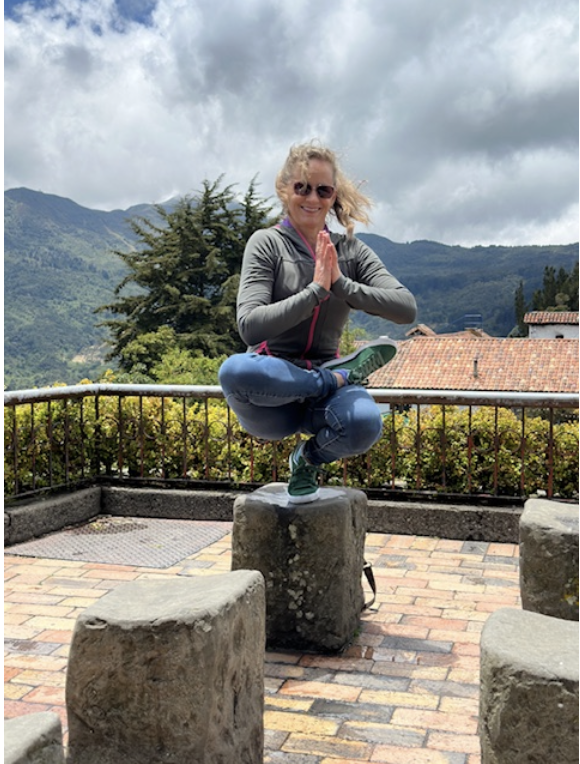
Museo Del Oro
My favorite place always has been the famous Museo del Oro or the Gold Museum. The collection of pre Colombian indigenous artifacts is amazing. Since my last visit over 30 years ago, the museum has added an auditorium, new exhibition rooms, a cafe, a restaurant, and a souvenir store. The museum has 55,000 pieces, of which 6,000 are on display.
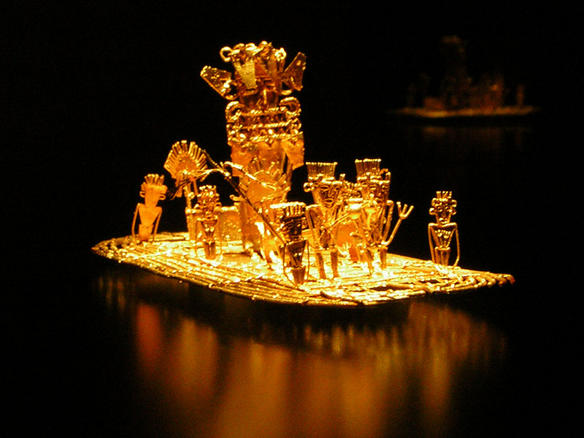
The prime piece of the museum is the famous Muisca golden raft found in 1969, that represents the basis for the El Dorado myth. El Dorado enticed Spanish and other explorers searching for the lost city of gold and emeralds. The zipa, a mythical tribal chief of the native Muisca people, was said to cover his body in gold dust, and from his raft, offer treasures to the Guatavita goddess in the middle of the sacred lake. The Muisca were as advanced as the Aztec, Inca, and Mayan civilizations.
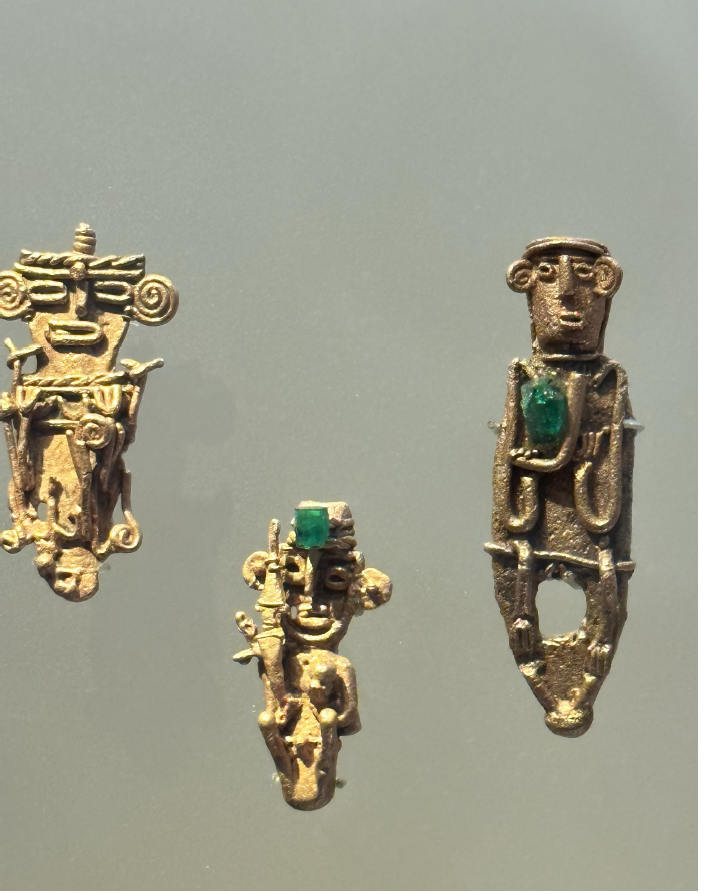
International Museum of Emerald
We continued to the International Museum of Emerald in the Avianca Building close to the Gold Museum. We were pretty disappointed with this one. You walk through a very small simulated mining operation, showing caches of emeralds in various types of geological formations. The guide did share some interesting gemological facts about emeralds along the way. From there you are guided into the sales room. Basically, a retail gem selling operation disguised as a museum.
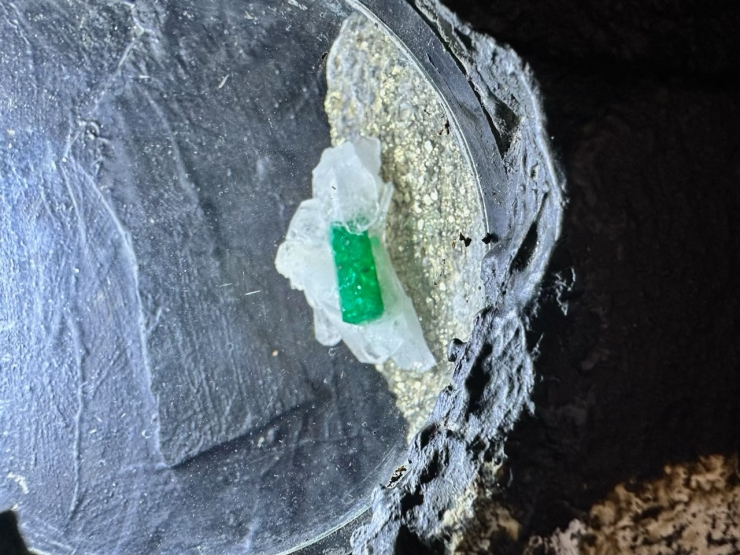
General Impressions of Bogota
Downtown can be pretty scary these days. The graffiti and poverty is rampant in this once beautiful city. There are definitely no-go zones right next to tourist hotspots, like Plaza Bolivar. We were warned never to use our phones in public but did so cautiously without problems.
There are a great many Venezuelans living in Colombia today due to the political situation in Venezuela. Something like 1/3 of Venezuelans have left the country since the dictator Maduro has taken over. You can see them in the streets hustling for money. The Colombians we talked to seemed irritated with them because they will work cheaper than the Colombians, driving down wages.
Once you get to the northern Zones and shopping districts, Bogota transforms into absolutely gorgeous neighborhoods on par with Polanco in Mexico City or Beverly Hills in its prime. Expensive well-manicured homes and foreign cars abound with top restaurants and clubs as well as super upscale shopping.
It takes a few days to get used to the money in Colombia. Of course, their currency is the Peso, but it's different than the Mexican peso we are familiar with. Instead of 17 to the dollar, each Colombian peso is about 4,000 to the dollar. So everything you buy in the street is in the thousands. When looking at stones, the numbers easily breach into the millions. Colombia is great for improving your math skills.
The food in Colombia is outstanding. Known primarily for its Argentinian and Colombian beef, you can order dishes long gone from the American cuisine like Chateaubriand. This is a meat lover's paradise. However, don't forget the empanadas, borrowed from Argentina. They can be filled with meat, vegetables, or desert cremes. Due to the strength of the Dollar and the Colombian Peso weakness, the price of everything is really inexpensive in Colombia with the exception of emeralds.
Searching for emeralds and treatment issues
We spent some time in the emerald district and old haunts looking at stones Everything we saw was treated, despite what the Colombian dealers said. We never felt comfortable with Colombian grading reports. No one would allow us to acetone their stones to prove no clarity enhancement! This leads to a discussion of emeralds and treatments.
This is the vital concern of buyers of emeralds. When I first started to go to Colombia, the dealers would say Colombian emeralds had Jardins (the Spanish word for Gardens, referring to the stone's inclusions). It was a romantic spin on the fact Colombian stones were generally quite included. This is due to the geological realities of how the stones are formed high in the Andes. Let's face reality, if the vast majority (99%) were not treated, we would not have an international emerald market. Therefore, emerald treatment is a fact of life, whether we like it or not. As a general rule, most collectors are searching for clean and green, non clarity enhanced emeralds. This small proportion of the emerald production is the creme de la creme of the market. The 2.86 image is what you are looking for. Expect to pay in the tens of thousands of dollars per carat for these rare gems.
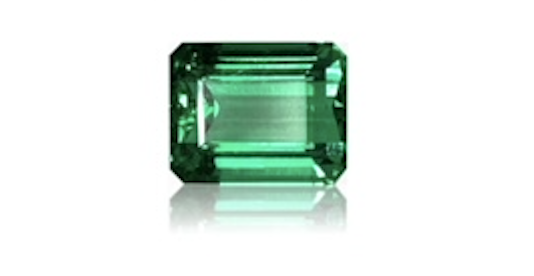
However, a recent client told me he hated untreated Colombian emeralds because they are so included and he preferred treated stones for their cleaner appearance. This got me thinking about the issue. What we see in the marketplace are dealers trying to game the system. They know that untreated emeralds sell for 300-500% more than treated emeralds. All they have to do is acetone the stones, submit the gems to a lab and market the stones as no clarity enhancement. However, what you end up with is a bunch of no clarity enhanced emeralds, but they are so grossly included that they should actually be treated. You often see these stones at gem shows and auction with high price tags. Better to be treated and beautiful than untreated and heavily included, in my opinion. I hope my client is reading this because point taken. Thank you.
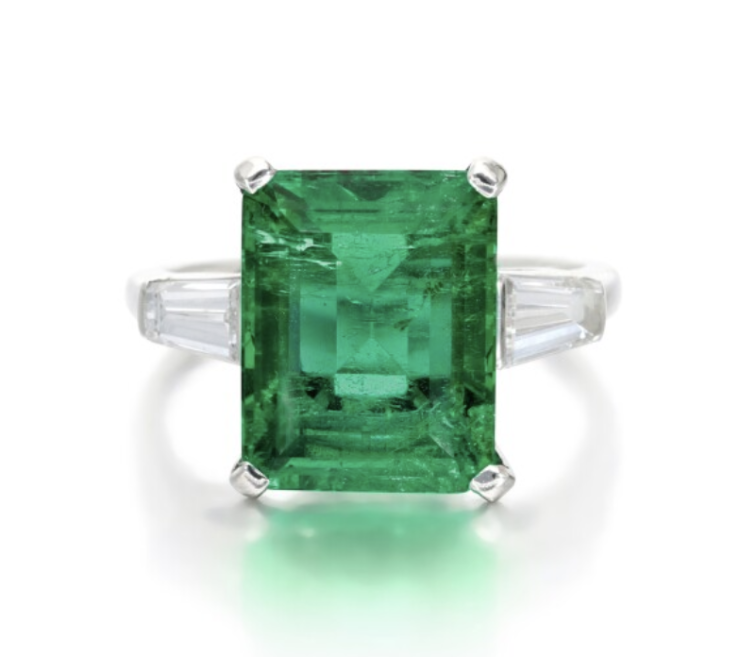
See this 3.92 being auctioned at Sotheby's? The price is over $49,500 per carat or $194,000. You can see the built in premium for the no clarity enhancement. Really the stone needs treated to try and hide these obvious inclusions. And the price lowered dramatically.
Which lead us to another important facet of these stones. As we know, 99% of all emeralds are treated. Can we just dismiss these stones for the no clarity enhanced stones? I do not believe so. Many clarity enhanced emeralds are beautiful and desirable. What I really want is transparency and disclosure. As long as the buyer is aware the stone is clarity enhanced, I have no problems with these rocks. See this beautiful Colombian emerald below.
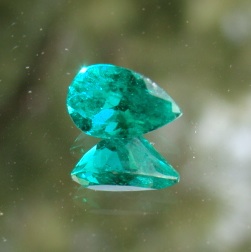
As readers know, a while back we resubmitted an emerald to AGL that stated no clarity enhancement. Turned out the stone was clarity enhanced somewhere along its journey. Same with Paraiba tourmaline (another historically included gem). The bottom line is if someone is trying to market you a stone as not clarity enhanced, simply demand a brand new AGL grading report. Because the labs are aware of this, you now see many hedge comments such as as at the time of testing the stone was not clarity enhanced or this gemstones contains fissures that at time of testing were not filled. They are covering their asses and suggesting to buyers to resubmit if a transaction is about to occur. It's worth the small investment to have the best available up-to-date information on any stone. Remember, unlike the complicated process of heating gemstones, oiling or epoxying stones is simple and easy to do.
Gemstone Rules Exception?
As a general rule, the largest percentage of the value of any gemstone is color. It's worth at least half of the total value of the stone. Some dealers contend more than 50%. They say we are buying colored stones not clarity stones. Clarity is also an important function of price in a colored gemstone. The average value given to clarity is approximately 20%-30%. When I first started going to Colombia, I noticed the stones that were light color yet clean were dramatically more expensive per carat than the more included greener stones. I thought this was ridiculous and never purchased these stones. After all these years, we are starting to think maybe the Colombians were right? Clean not enhanced stones are so rare from Colombia, they might be worth more than the included green stones, even if lighter in color. Perhaps the Colombians were right and emerald clarity represents a larger percentage of the value than color. Maybe we should make clarity 50% of the value of a an emerald and color 20-30%? The Colombians simply reversed the percentages, whether knowingly or not. Food for thought.
In Sum
The emerald market is treacherous, However, with a knowledgable dealer and correct brand new grading reports, you can protect yourself, whether you are a collector who puts the stones in your vault or you plan to mount them in jewelry. Same is also true if you are a jeweler or dealer. Trust but verify.
What about Bogota? Despite all the State Department warnings, we found Colombia to be a safe and fun place to vacation. You have to be careful in any large city, just like in Chicago or San Francisco. We found the people to be charming and friendly. Of course, it's hard to traverse the country without Spanish. Just go if you have always been fascinated with this South American country. However, it's probably smarter to buy emeralds here with a new AGL grading report.
Who knew the problems lab-grown diamonds would create? ED
Wedding planner Sterling Boulet has some advice for brides-to-be regarding lab-grown diamonds, which cost a fraction of the natural ones.
“If you’re trying to get your man to propose, they’ll propose faster if you offer this as an option,” says Boulet, of Raleigh, N.C. Recently, she adds, a friend’s fiancé “thanked me the next three times I saw him” for telling him about the cheaper lab-made option.
Man-made diamonds are catching on, despite some lingering stigma. This year was the first time that sales of lab-made and natural mined loose diamonds, primarily used as center stones in engagement rings, were split evenly, according to data from Tenoris, a jewelry and diamond trend-analytics company.
The rise of lab-made stones, however, is bringing up quirks alongside the perks. Now that blingier engagement rings—above two or three carats—are more affordable, more people are dealing with the peculiarities of wearing rather large rocks.
Esther Hare, a 5-foot-11-inch former triathlete, sought out a 4.5-carat lab-made oval-shaped diamond to fit her larger hands as a part of her vow renewal in Hawaii last year. It was a far cry from the half-carat ring her husband proposed with more than 25 years ago and the 1.5-carat upgrade they purchased 10 years ago. Hare, 50, who lives in San Jose, Calif., and works in high tech, chose a $40,000 lab-made diamond because “it’s nuts” to have to spend $100,000 on a natural stone. “It had to be big—that was my vision,” she says.
But the size of the ring has made it less practical at times. She doesn’t wear it for athletic training and swaps in her wedding band instead. And she is careful to leave it at home when traveling. “A lot of times I won’t take it on vacation because it’s just a monster,” she says.
The average retail price for a one-carat lab-made loose diamond decreased to $1,426 this year from $3,039 in 2020, according to the Tenoris data. Similar-sized loose natural diamonds cost $5,426 this year, compared with $4,943 in 2020.
Lab-made diamonds have essentially the same chemical makeup as natural ones, and look the same, unless viewed through sophisticated equipment that gauges the characteristics of emitted light.
At Ritani, an online jewelry retailer, lab-made diamond sales make up about 70% of the diamonds sold, up from roughly 30% two years ago, says Juliet Gomes, head of customer service at the company, based in White Plains, N.Y.
Ritani sometimes records videos of the lab-diamonds pinging when exposed to a “diamond tester,” a tool that judges authenticity, to show customers that the man-made rocks behave the same as natural ones. “We definitely have some deep conversations with them,” Gomes says.
Not all gem dealers are rolling with these stones.
Philadelphia jeweler Steven Singer only stocks the natural stuff in his store and is planning a February campaign to give about 1,000 one-carat lab-made diamonds away free to prove they are “worthless.” Anyone can sign up online and get one in the mail; even shipping is free. “I’m not selling Frankensteins that were built in a lab,” Singer says.
Some brides are turned off by the larger bling now allowed by the lower prices. When her now-husband proposed with a two-carat lab-grown engagement ring, Tiffany Buchert, 40, was excited about the prospect of marriage—but not about the size of the diamond, which she says struck her as “costume jewelry-ish.”
“I said yes in the moment, of course, I didn’t want it to be weird,” says the physician assistant from West Chester, Pa.
But within weeks, she says, she fessed up, telling her fiancé: “I think I hate this ring.”
The couple returned it and then bought a one-carat natural diamond for more than double the price.
When Boulet, the wedding planner in Raleigh, got engaged herself, she was over the moon when her fiancé proposed with a 2.3 carat lab-made diamond ring. “It’s very shiny, we were almost worried it was too shiny and was going to look fake,” she says.
It doesn’t, which presents another issue—looking like someone who really shelled out for jewelry. Boulet will occasionally volunteer that her diamond ring came from a lab.
“I don’t want people to think I’m putting on airs, or trying to be flashier than I am,” she says.
For Daniel Teoh, a 36-year-old software engineer outside of Detroit, buying a cheaper lab-made diamond for his fiancée meant extra room in his $30,000 ring budget.
Instead of a bigger ring, he got her something they could both enjoy. During a walk while on an annual ski trip to South Lake Tahoe, Calif., Teoh popped the question and handed his now-wife a handmade wooden box that included a 2.5-carat lab-made diamond ring—and a car key.
She put on the ring, celebrated with both of their sisters and a friend, who was the unofficial photographer of the happy event, and then they drove back to the house. There, she saw a 1965 Mustang GT coupe in Wimbledon white with red stripes and a bow on top.
Looking back, Teoh says, it was still the diamond that made the big first impression.
“It wasn’t until like 15 minutes later she was like ‘so, what’s with this key?’” he adds.
Another big fight over undersea emeralds and gold. ED
More than 300 years ago, a Spanish warship called San José sank near the coast of Colombia. Now, controversy surrounds the sunken vessel as the country looks to surface the galleon and collect an estimated $20 billion worth of treasure.
The San José was part of the Spanish Navy during the Spanish Succession that occurred between 1701 and 1717. The galleon was an enormous ship consisting of three masts and some 60-mounted guns.
According to Bloomberg, prior to sinking, the San José traveled throughout Latin America for six years and collected silver and gold from the mines of Peru. It is believed to have sunken in 1707 after battling with a British fleet with much of the treasure on board.
Colombian President Gustavo Petro recently ordered that the San José be brought to the surface to collect the gold, silver and emerald treasures that remain aboard. According to Bloomberg, the Colombian government is looking to create an archaeological lab to study the artifacts aboard the ship before placing them in a national museum.
According to Colombia's Minister of Culture, Petro aims to have the ship recovered before his term ends in 2026. But muddying the waters is a U.S.-based company suing the Colombian government for half of the treasure's value.
Sea Search Armada, the U.S. company suing the Colombian government, claims that it found the location of the San José in 1981 and gave the coordinates to the Colombian government with the agreement that they would be entitled to half of the treasure.
The Colombian government said it would abide by the court ruling. Still, it stated that the Colombian Military discovered the ship's location in 2015 after a joint search effort with the Colombian Navy and a marine exploration company called MAC.
The Colombian government also claims there is no shipwreck at the coordinates provided by Sea Search Armada, formerly known as Glocca Morra. Neither set of coordinates has been made publicly available at the time of publication.
Sea Search Armada is suing the Colombian government in a London court, according to Bloomberg, under the US-Colombia Trade Promotion Agreement. The agreement was enacted in 2006 to eliminate tariffs when trading goods and services between the United States and Colombia.
Due to space limitations, we had to cut this article, but wanted to include the vital parts. ED
When a Middle East royal recently let it be known that he was looking to invest upwards of $100 million in gemstones, word spread quickly and soon more than one well-connected dealer was jetting to the region with heavily insured valises. What might be most intriguing about this royal’s request is not the nine figures at play or even that all that cash was to be stashed in diamonds, rubies, and the like, but rather that this kind of high-dollar venture is not uncommon; in fact, it’s a growing trend. Top brokers say that since the start of this year, which has been marked by chaotic global events, more and more clients have been looking to invest in hard assets—namely jewelry and loose stones. Jewelry, after all, has long been a safety net. When currencies were devalued and stock markets plummeted, a top-quality diamond or other precious gem remained global currency. That still holds true today. “With bank and crypto failures and inflation, I definitely see more interest from clients who are thinking of jewelry as a store of wealth,” says Lee Siegelson, the current proprietor of the century-old New York dealer specializing in vintage pieces and rare stones that bears his family name.
When someone has tens of millions to invest, historically experts have advised putting it into fancy-colored diamonds and untreated rubies, emeralds, and sapphires—essentially the equivalent of blue-chip stocks. For those who have followed that advice, relax: Their stability hasn’t changed. But as the number of billionaires expands exponentially and people who were never serious collectors seek to diversify their portfolios with jewels, the most prized gems are becoming scarcer.
With the right provenance—namely Burma, Colombia, and Kashmir—colored stones are almost guaranteed to hold their value. But provenance alone isn’t enough. The gems must be verified as natural, meaning they have not been treated to enhance their color or quality. The difference in price between a treated and an untreated stone could be millions. “You can’t walk into a store and easily find untreated Colombian emeralds or Kashmir sapphires.” An untreated sapphire that comes out of the ground that color is significantly rarer and more desirable—and will only get rarer and more valuable. Securing one is akin to searching for a Picasso or a Giacometti: Some of the best examples may never come up for sale publicly, quietly trading hands between collectors. When the call that something interesting has surfaced comes, the dealers are ready to jump on a plane at a moment’s notice. It might not be offered again.
We had to cut for space here too. ED
Hello, everyone! I just got back from six days in Bangkok with my dad, and this is my report. There are plenty of dealers who live there and have a more comprehensive view, but these are my observations from conversations while buying and sourcing goods.
Prices are obviously higher for colored stones than before. Retailers and designers need to adjust their prices when requesting gems and quoting their customers. It’s just the nature of the beast these days. Don’t expect to pay what you did before the pandemic.
There are definitely still deals to be had, and we bought very well, including adjusting for the price hikes. The deals and quantity of goods are less available than before, and everyone is buying less because the prices are so high, but here are my top takeaways.
Fine-quality stones above 5–6 carats in Sapphire and 4-plus carats in Ruby are much, much harder to find in the market. Those prices will stay high. High upfront costs and outside players who have “eff you” money have got in on the action.
Very little production is coming out of Burma. If you have a customer who wants a larger, fine colored gemstone (especially a no-heat Ruby), tell them to buy now. It will only go up and it’s a good investment piece.
Rare Madagascar Color Change Garnet In the late 1990's, color change garnets were discovered in Madagascar and Tanzania, Africa. What was really cool is one side of these phenomenal stones are blueish grey or teal and the other side raspberry red. It was an example of the first blue garnet ever. We bought as many nice ones as we could before the supply
ran out. Most were carat sizes. Some clients noted they liked these color change garnets better then their alexandrites, which typically have one good side and one bad side.
Here is an example of a Madagascar Garnet with a strong color change or shift from red to purplish red, where both sides are beautiful. These are extremely desirable colors, are rare, and sell for a premium.
Color change garnets are one of the rarest and most fascinating gemstones. The color change can be intense and more dramatic than the color change of top quality alexandrite, which can sell for tens of thousands per carat. This is a smart stone to collect if you look for unique gemstones and undervalued gem bargains.
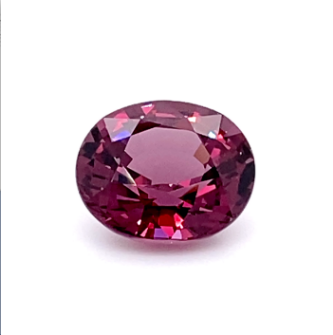 |
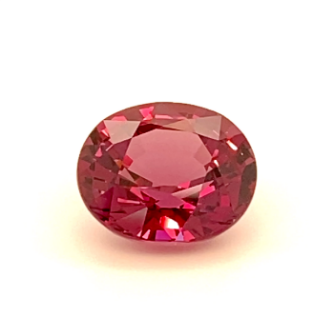 |
This one is available here:
https://www.preciousgemstones.com/inventory-for-sale/garnet-color-change/776-oval-color-change-madagascar-garnet